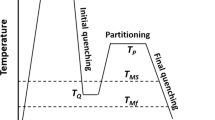Conclusions
We have shown that ultrasonic vibration with an amplitude of 20 μ and 12 μ at 250°C favors the decomposition of the austenite in KhVG steel, fragments the microstructure of the steel, and increases its hardness. Ultrasonic vibration of the same amplitude does not induce any significant changes in the steel at 200°C.
Similar content being viewed by others
Literature cited
K. M. Pogodina-Alekseeva, and G. I. Éskin, MiTOM, No. 1 (1956).
K. M. Pogodina-Alekseeva, In Coll: Modem Alloys and Their Heat Treatment [in Russian], Mashgiz (1958).
E. A. Al'ftan, Izvestiya vysshikh uchebnykh zavedenii. Chermaya metallurgiya, No. 9 (1960).
Author information
Authors and Affiliations
Additional information
Translated from Metallovedenie i Termicheskaya Obrabotka Metalov, No. 1, pp. 50–51, January, 1964
Rights and permissions
About this article
Cite this article
Aizentson, G.E., Malinen, P.A. Decomposition of residual austenite as the result of ultrasonic vibration. Met Sci Heat Treat 6, 43–44 (1964). https://doi.org/10.1007/BF00661973
Issue Date:
DOI: https://doi.org/10.1007/BF00661973




